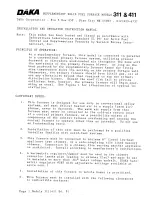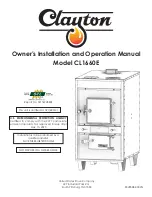
7
24
25
9. Replace blower door and secure with 2 screws. Turn
on electrical supply to your furnace. (See Fig. 16.)
*Factory provided with the furnace. Filters may be field modified by cut-
ting and folding the frame as indicated on the filter. Alternate sizes and
additional filters may be ordered from your dealer.
Combustion area and vent system
Inspect the combustion area and vent system before each
heating season. An accumulation of dirt, soot, or rust can
mean a loss of efficiency and improper performance. Build-
ups on the main burners can cause faulty firing. This
“delayed ignition’’ is characterized by an alarmingly loud
sound. If your furnace makes a loud noise when the main
burners are ignited, shut down the furnace and call your
servicing dealer.
Use your flashlight and follow these steps for inspecting the
combustion area and vent system of your furnace:
1. Turn off electrical supply to the furnace and remove
the access doors. (See Fig. 9, and 10 or 11.)
2. Carefully inspect the gas burner for dirt, rust, or scale
(see Fig. 26). Inspect the relief box, flue connection
area, and the vent pipe for rust.
UPFLOW FURNACE FILTER TABLE (IN.)
FURNACE
CASING
WIDTH
FILTER SIZE
FILTER
TYPE
Side Return
Bottom Return
14-3/16
(1) 16 x 25 x 1*
(1) 14 x 25 x 1
Cleanable
17-1/2
(1) 16 x 25 x 1*
(1) 16 x 25 x 1
Cleanable
21
(1) 16 x 25 x 1
(1) 20 x 25 x 1*
Cleanable
24-1/2
(2) 16 x 25 x 1*
(2) 12 x 25 x 1
Cleanable
DOWNFLOW/HORIZONTAL
FURNACE FILTER TABLE (IN.)
FURNACE
CASING
WIDTH
FILTER
SIZE
FILTER
TYPE
14-3/16
(2) 14 x 20 x 1*
Cleanable
17-1/2
(2) 14 x 20 x 1*
Cleanable
21
(2) 16 x 20 x 1*
Cleanable
24-1/2
(2) 16 x 20 x 1*
Cleanable
26
NOTE:
If dirt, rust, soot, or scale accumulations are found,
call your servicing dealer. DO NOT OPERATE THE FUR-
NACE.
3. Inspect the vent pipe for a sag, holes, or a disconnec-
tion. A horizontal vent pipe must slope upward. If rusty
joints or seams, or signs of water leakages are found,
call your dealer for service.
4. Replace the access doors and restore electrical supply
to the furnace. Be sure bottom door flange is inside of
the furnace casing. (See Fig. 14 and 15.)
5. Start the furnace and observe its operation. If possible,
watch the burner flames. Are they burning bright blue?
If not or if you suspect some other malfunction, call
your servicing dealer.
Before you request a “service call’’
Before you call for service, check for several easily
solved problems:
• Check for sufficient airflow. Check the air filter for dirt.
Check for blocked return-air or supply-air grilles. Be sure
they are open and unobstructed. If this isn’t the cause of the
problem, call your servicing dealer.
If your furnace isn’t operating at all, check the following list
for easily solved problems:
• Is your thermostat set above room temperature? Is the
switch in the HEAT position?
• Is the electrical power supply switch on? Is the blower
access door firmly in place? Are any fuses blown? (There is a
fuse on the furnace control.) Has a circuit breaker tripped?
• Is the manual shut-off valve in the gas supply pipe leading
to the furnace open? Does the lever point in the same direc-
tion that the pipe runs (open)? Or is it at a right angle to the
pipe (closed)?
NOTE:
Before proceeding with the next checks, turn off the
electrical power supply to the furnace. Remove access
doors.
• Is the control knob on the gas valve turned to the ON
position? If this or the preceding check shows an interrup-
tion in the gas supply, make sure the gas has not been shut
off for safety reasons. If nothing else seems to be wrong,
WARNING
If holes are found or if the vent pipe is obstructed
or is not connected, toxic fumes can escape into
your home. DO NOT OPERATE YOUR FURNACE.
Call your dealer for service. A failure to follow this
warning could result in personal injury or death.
!


























